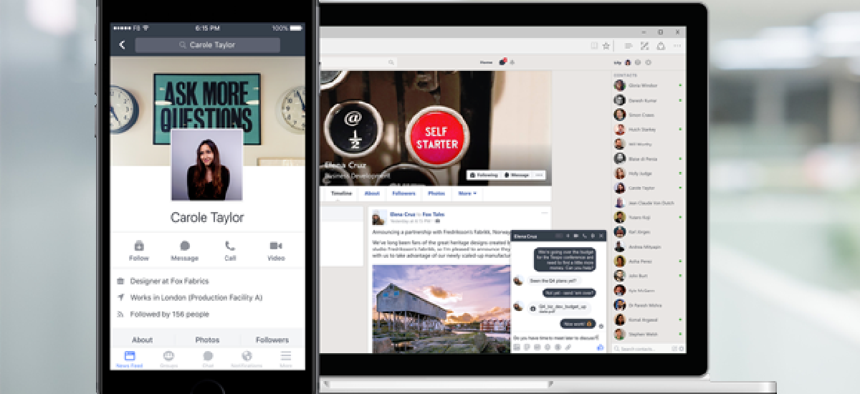Workplace by Facebook ramps up agency collaboration


Connecting state and local government leaders
The user-friendly interface isn't just making group discussions easier -- it's fostering conversations that weren’t likely to happen otherwise.
It’s not often that an employer encourages the use of Facebook at work, but Arizona state officials say internal communication has improved drastically by doing just that.
Since November 2015, the Arizona Strategic Enterprise Technology (ASET) Office has been testing Workplace by Facebook, formerly Facebook at Work, an app that allows for group discussions, voice and video calling and a personalized news feed -- all completely separate from employees’ personal Facebook accounts.
ASET’s goal was to find something other than email to use as a communications platform. In the process, it revolutionized internal communications, said Deputy State CIO J.R. Sloan.
“We have a sense that it has reduced email and that some of the conversations that would have been trying to take place in email or maybe would have required a meeting before, now can be a conversation on Workplace,” Sloan said. “The value that we didn’t see or expect at the beginning was this whole area of conversations that weren’t happening or weren’t really likely to happen without a tool like this.”
He’s referring to the use of Workplace by employees at all levels to have real-time discussions on important topics, such as the rollout of a new management system currently underway in the state. For example, managers can post a picture of their progress that all users can see -- something they weren’t likely to do via email, said Megan Rose, communications director at the Arizona Department of Administration (ADOA), ASET’s parent organization.
“One of the key things that’s really helped within the Department of Administration is the fact our agency director … has really embraced it and has led by example,” using it to deliver not only his own messages, but also to get involved in other conversations, Sloan said. “That just encourages everyone.”
Use of Workplace, which is voluntary, has “blossomed,” he added. The test started within ASET and expanded to include all of ADOA. ASET also extended an invitation to ADOA-run groups, such as the Project Management Center of Excellence, marking the state’s first foray into cross-agency communication on the platform. Today, almost 1,000 users are on the system, and two other agencies -- the departments of Child Safety and Game and Fish -- are piloting it, too.
Sloan credits familiarity with the ease of adoption. “Because people are so familiar with the Facebook metaphor, they seemed very comfortable in joining into a conversation. That allowed our senior leadership to be distributing key messages, for groups to form naturally, to allow cross-division communication,” he said.
Through an interface that mimics Facebook, Workplace lets users create groups and set privacy parameters. To kick off a conversation within the group, a user can write a post; add a photo, video or file; or take a poll of group members. User profiles include a photo and contact information, and coworkers can choose to “follow” one another, meaning the followed coworker’s posts will show up in the follower’s news feed. For more private conversations or voice and video calls, there’s Work Chat, which looks much like the Facebook Messenger many are familiar with.
Until now, Arizona agencies have relied primarily on email for such communications, but it’s easy for messages to get lost in a long email chain or just pushed down in a busy inbox. Workplace uses the same tracking tools that Facebook does, which means users can see who has read what they wrote.
One area that ASET is still nailing down with Facebook is how to comply with freedom of information and public records requests, because the conversations on Workplace are subject to such inquiries. For now, ASET is “preserving the data from Workplace on a daily basis, and we’re archiving that ourselves so that we can go back to any point in time that we need to, to pull relevant information,” Sloan said.
He encourages other state officials who are considering Workplace not to shy away from it and to issue usage guidelines on what’s appropriate to post (e.g., if you can’t say it in front of human resources, don’t post it).
“This is the kind of tool that the new generation of government workers is looking to have when they come in,” he said. “This is how the next generation wants to communicate and the types of tools they use to communicate every day. They will accomplish things faster and better with tools like this at their disposal.”
Ultimately, the goal in Arizona is to roll Workplace out across all state agencies, creating a single platform that can quickly deliver messages to every employee. “This has become a key tool in the toolkit for how we manage and are managing the rollout of new initiatives within Arizona,” Sloan said.




